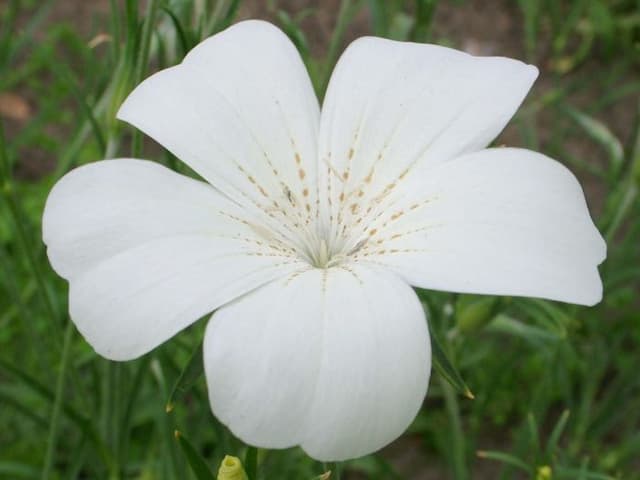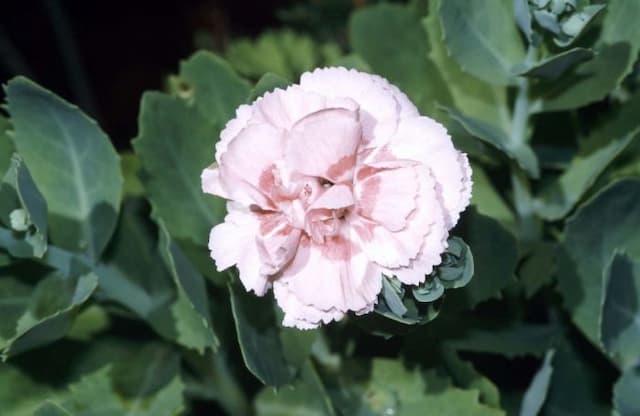Pink Dianthus 'Dainty Dame' (p)

ABOUT
Dianthus 'Dainty Dame' is a charming plant with an attractive appearance, boasting a delightful assembly of flowers that command attention. The blossoms, which are the highlight of the plant, exhibit a sweetly fringed or lightly serrated edge, providing a delicate, lacy look. The flowers come in a dreamy palette of pink, featuring shades that can range from a soft, pale pink to a more vibrant, deeper hue, often with subtle variations that give each bloom its unique character. The petals commonly have a richly contrasting eye, composed of a darker shade of pink or even a burgundy, which adds depth and an engaging focal point to the flowers. They exude a pleasant and spicy fragrance that is typical for the species and irresistibly draws in both admirers and pollinators alike. The foliage of Dainty Dame forms a dense clump of narrow, linear leaves with a blue-green to grayish-green color, providing a fitting backdrop that makes the vibrant colors of the flowers truly stand out. The leaves are quite slender and can have a slightly wavy or straight appearance, often forming a mound-like or cushioned base for the flowering stems. Overall, the neat and compact growth habit of this plant adds to its grace, making it a popular choice for garden enthusiasts seeking to infuse their garden with a touch of elegance and charm.
About this plant
 Names
NamesSynonyms
Dainty Dame Dianthus, Maiden Pink, Dainty Dame Carnation, Dainty Dame Sweet William.
Common names
Dianthus 'Dainty Dame'
 Toxicity
ToxicityTo humans
The Dianthus 'Dainty Dame', commonly known as Carnation, is generally considered non-toxic to humans. Accidental ingestion of parts of the Carnation plant typically does not result in poisoning or serious side effects. However, as with many plants, sensitive individuals may experience mild gastrointestinal discomfort or an allergic reaction if they consume or handle the plant.
To pets
Carnations can be mildly toxic to pets if ingested. Symptoms of ingestion in pets may include mild gastrointestinal upset such as vomiting or diarrhea. It is advisable to prevent pets from consuming this plant to avoid these potential adverse reactions.
 Characteristics
CharacteristicsLife cycle
Perennials
Foliage type
Evergreen
Color of leaves
Blue-green
Flower color
Pink
Height
1 foot (30 cm)
Spread
1 foot (30 cm)
Plant type
Herb
Hardiness zones
5
Native area
Europe
Benefits
 General Benefits
General Benefits- Easy to Grow: Dianthus 'Dainty Dame' is known for being easy to cultivate, requiring minimal care once established.
- Attracts Pollinators: The plant's flowers can attract butterflies and other beneficial pollinators to the garden.
- Long Blooming Period: It typically has a long flowering season, providing color and interest in the garden for an extended time.
- Drought Tolerant: Once established, the plant has good drought resistance, making it suitable for drier climates or water-conserving gardens.
- Fragrance: The blooms of Dianthus often have a pleasant, spicy fragrance that can add an olfactory dimension to the garden space.
- Ground Cover: Low-growing varieties of Dianthus can serve as effective ground covers, filling in spaces and suppressing weeds.
- Cold Hardy: Dianthus is generally cold-hardy and can tolerate frosts, making it suitable for gardens in cooler climates.
- Versatile Use: The plant can be used in various ways in the garden, including borders, rockeries, and containers.
- Cut Flowers: The blooms make excellent cut flowers, adding charm and color to indoor arrangements.
- Non-Invasive: Dianthus tends to be non-invasive, ensuring that it won’t overtake the areas where it is planted.
- Deer Resistant: It is typically resistant to grazing by deer, which is an important consideration for gardeners in areas with deer populations.
 Medical Properties
Medical PropertiesThis plant is not used for medical purposes.
 Air-purifying Qualities
Air-purifying QualitiesThis plant is not specifically known for air purifying qualities.
 Other Uses
Other Uses- Carnation 'Dainty Dame' petals can be used as a natural dye for fabrics and textiles, offering a range of pink hues depending on the mordant used.
- The flower's clove-like scent can serve as an insect deterrent when placed among linens and clothing.
- Pressed carnation blooms can be incorporated into decorative paper or bookmarks for a touch of natural beauty.
- Dried carnation petals can be used in homemade potpourris to create a pleasant fragrance in the home.
- The flowers can be crystallized with egg whites and sugar to create edible decorations for cakes and desserts.
- Carnation plants can be used in a living mulch capacity to suppress weeds and retain soil moisture in garden beds.
- These carnations can serve as indicators of soil pH, as the flower colors can change based on the acidity or alkalinity of the soil.
- The blooms can be used for botanical art projects, such as making flower mandalas or floral mosaics.
- Carnation petals can provide an aesthetic element to handmade soaps, bath bombs, and other body care products.
- Brewed carnation petals can be used to make a fragrant rinse for hand-washing delicate fabrics.
Interesting Facts
 Feng Shui
Feng ShuiThe Carnation is not used in Feng Shui practice.
 Zodiac Sign Compitability
Zodiac Sign CompitabilityThe Carnation is not used in astrology practice.
 Plant Symbolism
Plant Symbolism- Love: Dianthus is often associated with love and affection, owing to its charming and vibrant blossoms.
- Admiration: The dainty and delicate appearance of the flower can symbolize admiration and fondness for someone's grace and delicacy.
- Boldness: Despite its name 'Dainty Dame', Dianthus flowers can represent boldness and daring due to their bright colors and spicy fragrance.
- Devotion: The longevity of the plant can be symbolic of long-lasting commitment and devotion between partners or friends.
- Purity: The clear and vivid colors of the 'Dainty Dame' often represent purity and innocence.
 Water
WaterCarnation 'Dainty Dame' requires regular watering to keep the soil consistently moist, but not waterlogged. Typically, water these plants with about 1 inch of water per week, adjusting for rainfall. The best method is to water at the base of the plant, avoiding wetting the foliage, which can lead to fungal diseases. During the growing season in spring and summer, you might need to water twice a week especially if the weather is particularly dry or hot. In cooler months or when the plant is dormant, reduce watering to prevent soil from getting too soggy.
 Light
LightCarnations prefer full sun locations where they can receive at least six hours of direct sunlight daily. An east or south-facing spot is ideal to ensure your Carnation 'Dainty Dame' gets enough light without the intensity of the late afternoon sun, which could be too strong during the peak summer months. Avoid placing it in full shade since insufficient light can lead to poor blooming.
 Temperature
TemperatureCarnations thrive in moderate temperatures and perform best when daytime temperatures are between 60 to 70 degrees Fahrenheit and nighttime temperatures are cooler, around 50 to 60 degrees Fahrenheit. They can tolerate a minimum temperature down to around 40 degrees Fahrenheit, but growth will be stunted below this range. Maximum temperatures for healthy growth shouldn't exceed 80 degrees Fahrenheit.
 Pruning
PruningPrune Carnation 'Dainty Dame' to encourage bushier growth and more prolific blooming. Deadhead spent flowers regularly to promote continuous blooming throughout the season. Additionally, conduct a more thorough pruning in early spring or late fall by removing dead or leggy stems. Pruning is also the time to shape the plant and control its size. The best time for significant pruning is after the last frost in spring or when the plant becomes dormant in fall.
 Cleaning
CleaningAs needed
 Soil
SoilSweet William requires well-draining, loamy soil with a pH range from 6.0 to 7.0. A good soil mix for Sweet William would be composed of two parts garden soil, one part sand or perlite, and one part compost or peat moss to ensure fertility and drainage.
 Repotting
RepottingSweet William should be repotted every 1-2 years to refresh the soil and accommodate root growth. It's generally done in spring or autumn.
 Humidity & Misting
Humidity & MistingSweet William prefers average humidity levels; it does not require any special humidity considerations beyond natural ambient indoor levels.
 Suitable locations
Suitable locationsIndoor
Use bright light, well-draining soil, and water sparingly.
Outdoor
Full sun to part shade, fertile, well-drained soil.
Hardiness zone
3-9 USDA
 Life cycle
Life cycleDianthus 'Dainty Dame', commonly known as Pinks, begins its life as a seed which upon germination, under suitable temperature and moisture conditions, emerges as a small seedling. The seedling grows into a vegetative stage characterized by the formation of a rosette of blue-green leaves, and the plant begins to develop a robust root system. As it matures into the flowering stage, typically in late spring to early summer, it produces scalloped flowers that offer a range of colors from white to pink with unique markings. After pollination, often by bees or butterflies, the flowers produce seeds which can be collected and dispersed to enable the next generation of Pinks to grow. Once the flowering period concludes, the plant will often enter a period of dormancy, especially in cooler climates, before resuming growth in the following spring. Over time, the perennial characteristics of Dianthus 'Dainty Dame' allow it to survive for several years, going through repeated growth and dormancy cycles.
 Propogation
PropogationPropogation time
Spring to Summer
Dianthus 'Dainty Dame', commonly known as Pinks, is typically propagated in the late spring to early summer when the plant is actively growing. The most popular method is through softwood cuttings, which involves taking a 4 to 6-inch cutting from a non-flowering stem, stripping the lower leaves, and dipping the cut end into a rooting hormone powder. Then, plant the cutting in a well-draining soil mix, ensuring at least two sets of leaf nodes are below the surface. The container should be placed in a warm, bright area but out of direct sunlight to encourage root growth, and the soil should be kept consistently moist without being waterlogged. Roots usually develop within two to three weeks, after which the new plants can be gradually acclimatized to outdoor conditions before transplanting.








![Pink [Bubblegum]](/_next/image?url=https%3A%2F%2Fplants-admin.emdemapps.com%2Fimages%2Fplants%2F%2Fimages%2F604b596f31cbb.png&w=640&q=75)
